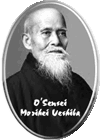|
Some words about Aikido
Aikido is synonymous to the martial art of peace. It is a modern Japanese martial art without any competition. It was derived
from traditional martial arts including Samurai sword fencing and unarmed combat by Morihei Ueshiba over the period of the
1930's to the 1960's.
Aikido uses principles of energy and motion to redirect, neutralize and control attackers. For its techniques to be effective,
size and strength are not important, hence Aikido is practiced by men and women alike. Aikido training is for all-round physical
fitness, flexibility and relaxation.
Through aikido practice we learn that tension and aggression are not the most powerful nor the most effective responses
to conflict. It is only when we are relaxed and move fluidly using our centre that we are most successful in our techniques.
The heart of Aikido is about acknowledging, accepting, and working with an attacker's energy, being willing to adapt and change
as necessary.
Some Elements of our Aikido Classes
Puma Shuseikai abides by the teaching standards established for all member dojos of SHUSEIKAN AIKIDO FEDERATION.
*REI
Our instructor begins each session with the traditional sitting bow. The initial bow is directed towards the image of
the founder together with the practitioners in attendance. He then faces the students and bows to them as they mutually utter
"ONEGAESHIMASU" verbalizing the intention to learn and practice in harmony together.
*WARM-UP (JUMBI TAISO)
Our instructor leads the session (sometimes appoints a senior student to lead the session) in executing a series of breathing
and stretching exercises sequence as learned from Fujimaki Sensei.
*UKEMI (Rolling Exercise):
Our instructor pays attention to the details in movement that will lead to the satisfactory execution of UKEMI. Correct
position of hand, feet and head are checked to make the student internalize the importance of safety and balance in UKEMI.
Zempo Ukemi (Front roll):
Proper arm positioning is emphasized making sure that the support arm is firm, stable and unbendable; the free hand is
extended while the head is in a tucked-in position for a safer roll.
Koho Ukemi (Back roll):
Extended arm, head bent to the side and the free hand at shoulder level for an easier roll.
Shikko:
Feet are on a seiza position. Back foot always follow front foot and always closed to each other.
Yoko Ukemi (Side fall):
Slamming of hand are given emphasis. Only the side of the back touches the mats. Head does not touch the mats.
*Kihon Kamae (BASIC STANCE):
Shoulders are facing front. Both arms extended as if you are holding a sword. The stability of the stance are checked,
front foot is bent and back leg is straight.
The distance of feet is wide enough having the stability of the stance. Pushing the chest/shoulder determines the stability
of the stance.
* Kihon Unsoko (BASIC FOOTWORK) (ASHI SABAKI)
The practice of basic footwork is a part of any session. The fundamentals of Aikido are rooted in the feet.
Okuri ashi:
Front foot moves first followed by back foot but it does not touch each other. Distance of feet is the same as you have
started.
Tsugi ashi:
Back foot moves first and touches the front foot then foot moves again to the front to end positioned as if you are in
a starting position.
Ayumi ashi:
Back foot on side position moves ahead of front foot as if you are walking.
Tenkan:
Front foot turns the ball of his foot 180 degrees followed by the back foot.
Tenkai:
Use your hip to turn to back while your weight goes to the front as you move and cutting hand is extended.
Teaching of Techniques
We teach Aikido techniques based on the fundamental principles of non-contention combined with breathing methods which enhance
the execution and movement of the practitioner. However, our instructor always keep in mind that techniques are classified
into three major types, namely:
Kata (Form):
Means the step by step of hand and body as well as the footwork in order to do the movement properly.
A technique is broken down into every movement emphasizing each of its importance.
Flow/Fluid:
This means that the technique being done is flowing or is fluid, it does not stop at the middle of the technique. It
gives more emphasis on circular movements.
Force:
This gives more emphasis on the practical or the effectiveness in the application of the technique.
In ending our session
*SITTING KOKYU-HO (SUWARIWAZA KOKYU-HO)
The end of all sessions is marked by these breathing exercises to instill the importance of "musubi" or "harmonizing
with one's partner".
*COOL DOWN EXERCISE
A set of cool-down exercises were done by asking practitioners to partner with each other.
*REI
Instructors and student pays respect to the SHOMEN and then, to each other. Everybody says "thank you"; or "ARIGATO
GOZAIMASHITA"; to both teacher and fellow practitioners alike as bow is executed.
|

